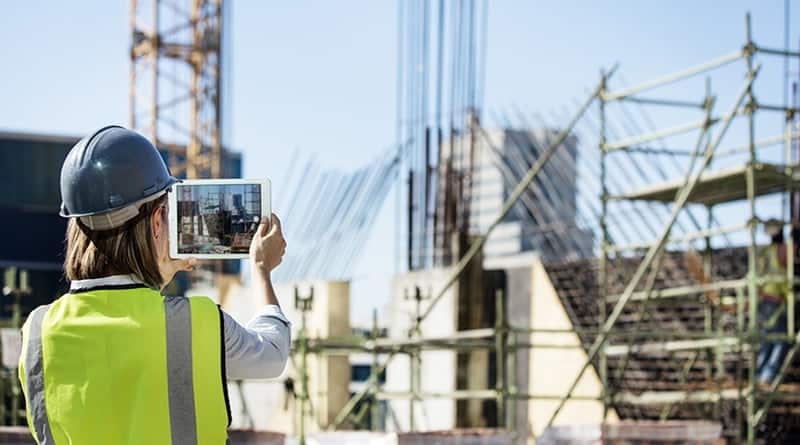
In fact, here are some of the most notable trends that experts believe you should expect to see in the construction industry next year:
1. Augmented reality
Construction World magazine says that while virtual reality has been an emerging trend in recent years, it is quickly becoming obsolete – especially when compared to the uses and benefits of augmented reality. This is the ability to view the real world through a camera lens.
It is about to open up many new opportunities for the construction industry, even if it comes at a cost. For companies that can afford to start using it now, it will revolutionize the way they design and build things. This is a trend that will grow much more in the coming years.
In fact, many people believe that, instead of wearing safety glasses, we will start planning and designing the locations before we even start working.
2. Collaboration software and data ecosystem
Real-time collaboration software is already considered an essential component of the entire construction process. However, its impact on the sector is expected to increase substantially in the near future. With some boldness, it can be said that collaborative data has played a fundamental role in this paradigm shift in construction.
The emergence of a data ecosystem in which all innovative industry participants will come together and share project data, experience and knowledge is closer than we could have imagined. And it is no exaggeration to say that this is the only way forward for construction.
The ability to integrate your existing processes and systems on a single, fully connected platform can empower the way people in the industry work. A multitude of software solutions for different functions and disciplines in the course of a construction project can now be easily combined in one place.
Mainly with Blockchain technology that today is widely used by cryptocurrencies. A chain of blocks, surrounded by a robust encryption layer. The blockchain is public, and any individual can check and audit the various transactions with records on it.
The use of digital tools facilitates the accumulation of this valuable information and, by extension, minimizes delays, rework rates and communication failures between the construction site and the office.
In this sense, it is expected that a reliable collaborative software in real time will function as a digital backbone for the construction process from start to finish.
3. BIM will continue to grow in 2021
Similar to last year, BIM is again one of the most popular construction technology trends. It is not surprising if we take into account that the emergence of an open and highly collaborative data ecosystem is underway.
BIM technology can be the catalyst for a fundamental change in the way we manage, design and develop a construction project. There are many different levels of programming enabled through BIM. 4D and 5D BIM are two very representative examples in this direction.
From a general point of view, BIM will bring more precision to the construction process and will enable the exchange of important information about the project between the various stakeholders. In addition, it is expected that their further evolution will make construction projects more productive and accessible, including revolutionary sustainability and safety measures.
It is evident, then, that BIM could act as a game changer for construction and offer a detailed description of the project’s development in an open and highly collaborative environment.
4. Greater prefabrication, modularization and eco-friendly
There has been an increasing trend towards multi-trade prefabrication. This is something that the Multi-Commerce Prefabrication Conference is addressing now. It was the first multi-trade conference held for the growing number of construction companies that are implementing prefabrication strategies.
A great example of this occurred in Dubai, where a 3D office building was printed in 17 days, followed by another 2 days in the assembly. Many experts in the civil construction sector believe that we will continue to see this practice grow in the coming years, especially since the cost and time are no longer so prohibitive.
This does not mean that they are no longer problems, simply that they are being addressed in a way to help boost this sector.
Another growing trend is industrialized modularization of construction. This trend is similar to prefabrication, and many people see it growing in popularity in the years to come.
This type of construction is associated with prefabricated ones, where the components can be produced both in specialized factories and on the construction site itself. Its characteristics combine speed of execution of the work with the final quality, due to stricter quality standards and more specialized employees.
There are already some construction companies that have started to implement these strategies in the way they run their operations. The benefit here lies in the fact that standardization reduces costs and lead times.
All of these processes are very beneficial in the following three ways:
They are very environmentally friendly because when working on building a factory you can easily recycle any extra material. This is much better than what was happening with traditional construction practices – many of which would be forced to send large quantities of waste to landfills.
Prefabrication saves a lot of money because construction companies can get massive discounts on materials. This also saves time, which in turn saves even more money.
Since all work takes place in a factory-controlled environment, there is less risk of problems that are normally associated with things like humidity, environmental hazards and dirt. In addition, it is also less likely that construction workers and eventual project lessees will be exposed to climate-related health risks.
5. Self-regenerating concrete
Many industry experts believe that we will begin to see self-healing concrete being used on roads, buildings and homes.
As concrete is the most widely produced and consumed material in the construction industry (being used to create buildings, roads and bridges), many believe that by 2030 we will be using around 5 billion metric tons per year.
Part of this is due to the urban boom that is being experienced in China and India today. Currently, the United States already represents 8% of total global emissions in this area – a number that is also expected to rise.
6. Drones
Many construction sites are already highly dependent on the use of drones. These drones are very beneficial, as they save a lot of time.
For example, surveyors can search an entire site in just a few minutes, whereas in the past they would have taken several weeks or months. Of course, this will also save a lot of money for construction companies.
As drone technology continues to evolve rapidly in its accuracy and precision of its readings, even less human involvement will be required.
In the past, many companies were hesitant to use drones because they still needed a controller, but today, as the technology becomes much more efficient, more construction companies are adhering to this technology.
7. Robotics
Robotics is something that should not be overlooked. Industries like healthcare are already investing a lot of money in them. As these robots become even more accurate and intelligent, they will become a dominant force in the construction industry.
In the beginning, the cost of robotics will be high, but it will still be worth at least paying attention to this technology. Eventually, we can witness robots being able to do things like laying bricks and tying rebar, we can even see them completing most of today’s man-made construction projects.
8. Cloud and mobile technology
A few years ago, most people didn’t know or couldn’t explain what a cloud operating system was. Today, this is no longer the case. In fact, most mobile devices can take advantage of cloud technology from anywhere, anytime.
There are many great advantages to this, including storing almost unlimited amounts of information that you can share instantly at the touch of a button. This is much less expensive too – about a tenth of what old technology sharing cost.
As the commercial cloud-based telephone system is accessible from anywhere you have an Internet connection, you can expect it to become a mandatory part of the construction industry in the future, especially if you want to stay competitive .
9. Advanced uses for GPS
Construction World experts say that while GPS tracking solutions are not new, they are now being used in more creative and ingenious ways, including:
The research has been drastically improved because the teams no longer need to use traditional surveying equipment.
Land data for evaluating potential projects can be collected quickly and accurately.
Project managers are also using GPS in fleet management. Today, each of its vehicles is equipped with a device trackable via computer and smartphones. This lets everyone know where the vehicles are. Especially in infrastructure works such as roads, ports and dams with a large volume of material transport.
It is easier to find lost or stolen equipment because managers can now generate maps that identify the exact location of any of these items.
Many people in the construction industry feel that we are nowhere near seeing an end to the growth of GPS technology today. Not only are applications in autonomous vehicles and wireless technology on the rise, but we are forced to see driverless vehicles as well. This will no longer be something that we only hear about Uber, construction companies will also use them. In fact, the general public will likely have these vehicles available to them starting in 2020.
They will see it in the form of buses, trains and trucks, but the construction fleets are not far away. There are many professionals who are currently working on autonomous vehicles that will make workplaces even more efficient.
For example, both Caterpillar and John Deere are currently working on tractors that will have automatic blade control and we hope that they will take this even further and create fully autonomous and driverless versions of these vehicles as well.
We are also witnessing the construction industry borrowing from the mining sector. Specifically, there is a driverless device that Tokyo-based Komatsu uses GPS to move high-quality ore.
As the number of these driverless vehicles continues to grow, we will have a reliable and powerful guide to automated machinery. We will also testify that GPS tracking solutions are reliable for positioning and integrating sensors, so they can prevent accidents and ensure everyone is safer.
10. New effective scanning solutions
Digitization is now creating many cost-effective solutions in recent years. This helped the construction industry to fully understand what stages certain projects are in.
Usable technology
Although many people may think that this is just common sense, it should not be overlooked that wearable technology. Whether in the form of watches, bracelets or even virtual reality glasses, these devices evolve quickly and are increasingly accessible to the general public.
Armbands that can communicate with digital exchanges behind the scenes will become a useful emerging trend for keeping workers safe. This will help prevent employees from constantly failing to follow your instructions, because they can now talk to each other using this technology, receive warnings or alerts.
In addition, it can help track where workers are if there is an accident. This is bound to become mandatory at some point in the future.
Concluding!
Undoubtedly, construction in 2021 should be a year ahead for the sector. Data-driven indicators, with an emphasis on collaboration and real-time communication.
For those looking for construction-oriented innovations in 2021, they are likely to expect higher productivity rates, less project delays and consequently more competitive construction costs.



